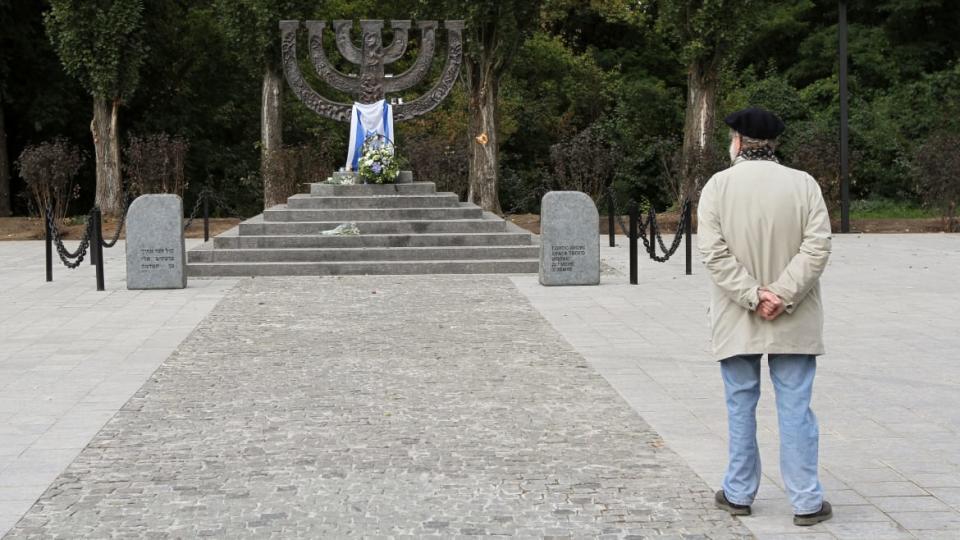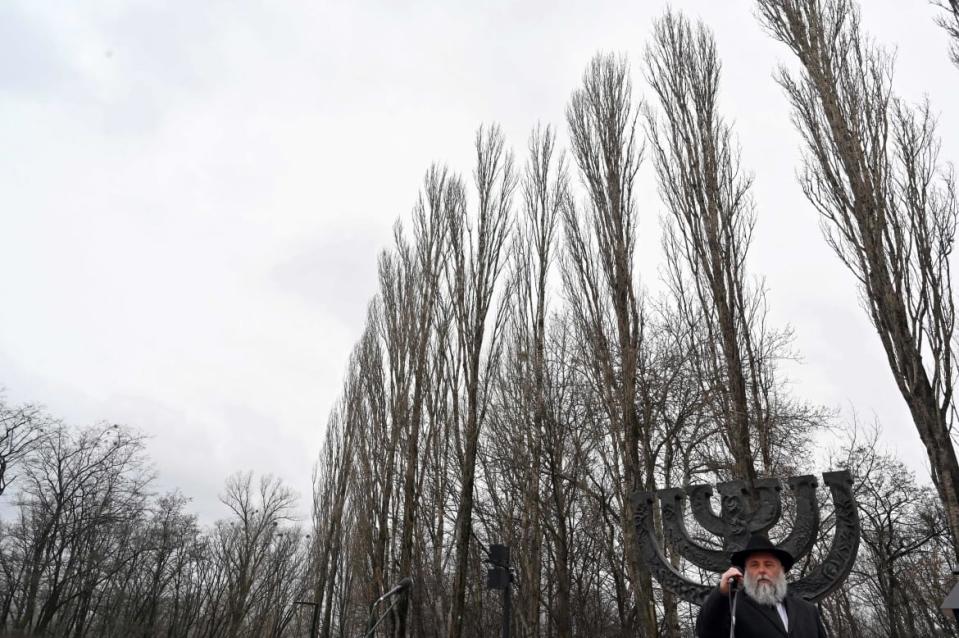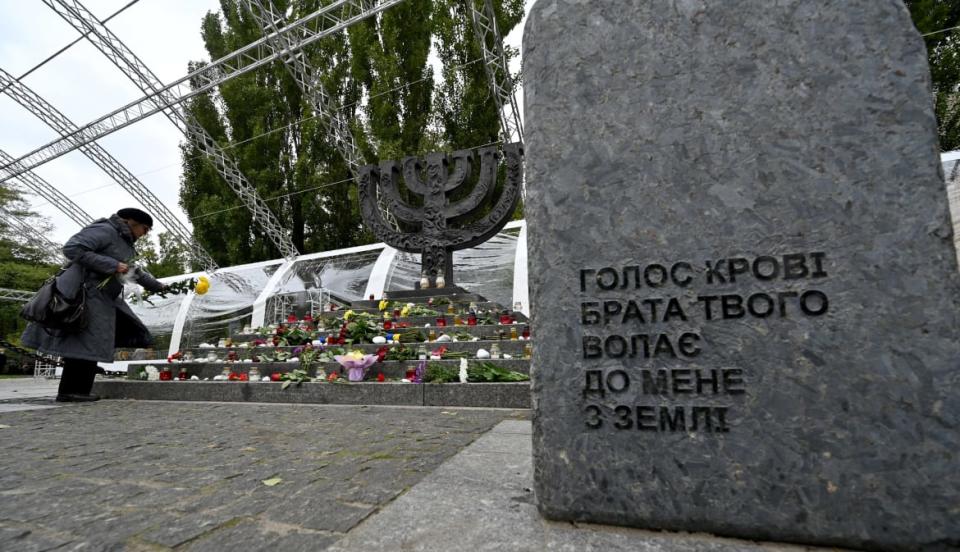A Massacre in a Park, a Miracle Survivor, and a Stash of Hidden Letters

KYIV—Barely anyone made it out of Babyn Yar alive. Out of the estimated 33,771 local Jews taken to this park to be shot and discarded, maybe a handful survived. One of those was Nadia Elgart, and her survival was considered so remarkable that it was recorded on her gravestone in 1978: “Nadia Elgart, the woman who escaped from Babi Yar on September 29, 1941 with her 6-year-old son.”
Babi Yar is the Russian name imposed during Soviet times on the local park which the Nazis, who invaded Ukraine in June, 1941, turned into the site of an urban massacre.
It is estimated that some 15,000 additional Jews were captured and killed in other places around Ukraine’s capital city during those fateful September days. But by the end of the war, the Nazis had murdered about 100,000 people in Babyn Yar alone. Father Patrick Desbois, an expert on the genocide that occurred outside of concentration camps, called the massacre “Holocaust by bullets,” the opening volley of the German plan to exterminate Jews.
Nazi Salutes and Fascist Chic Put Ukraine’s Jews on Edge
Today, as until the spring and early summer of 1941, grandparents amble about pushing strollers. Teenagers make out on cement benches. Youngsters slurp ice-cream cones. Some adventurers like to climb up and down the jagged, unkempt gullies which give the park an air of wilderness. Stately residential high-rises surround the green space.
Nadia lost 26 members of her immediate family in that park, including her parents, her sisters and her nieces and nephews. After their escape, her son Ilyusha was sent to an orphanage, and Nadia joined the Ukrainian partisans and fought the Nazis. She reunited with her son when he was 10, the family returned to Kyiv, and no one spoke of the war.
In 2017, Marina Vorobeichik, Nadia’s 48-year-old granddaughter, stumbled upon a stash of letters written by her grandmother, who passed away when Marina was only 5 years old. The Daily Beast is publishing excerpts from the letters for the first time in English here.
After the liberation of Kyiv, Nadia wrote to local authorities to denounce a maintenance man who had betrayed the surviving members of her family. She wrote that she had seen him walking around the neighborhood, wearing a suit that belonged to her husband, Lazar, who was serving in the Red Army. In the letter, written in February of 1945, Nadia described returning to her sister’s house to get some clothes after the massacre and how, in a desperate attempt to save what was left of her family, she bribed the maintenance worker “with all my property” only to see him walk over to a German officer two days later, and hand over a disabled relative who lived in the same home.

“My neighbor Zelensky, who lives in this building even today, had warned me to leave because they were looking for me,” she wrote. “Zelensky’s wife told me that my 12-year-old nephew, who she’d seen me walking around with, was alive in Kyiv, in Stalinka. During daylight I was afraid to go out, but in the evening I went out and found others alive who told me he’d crawled out of the dead and fled…”
Nadia had decided to go looking for her nephew—and leave Kyiv. “On our way, I gathered my courage and went to the maintenance man and said we had no clothes, and, knowing he had a lot of belongings, I said, uncle Pablo, give [my nephew] something to wear, a 12-year-old boy who was born and raised in this building… I said, uncle Pablo, please preserve the pictures of my mother and sister.”
Instead of helping her, Nadia wrote that Pablo had turned her into the building’s coop board, whose chair tried, and failed, to hand her over to the Germans before she could escape. Her nephew’s fate remains unknown, and whether Pablo was ever prosecuted has been lost to history.
In another of the secret letters, written in 1944 by a truck driver named Ivan Nikolaevich Kazakov, he describes three years of agonizing self-recrimination because he’d transported Nadia back to Kyiv from the city of Lvov before either knew that the Germans had already taken the city. Only after dropping her off did he learn the fate of Kyiv’s Jews. He wrote to ask whether Nadia and her mother had survived.
In 1946, a woman named Sofia Markovna Litvinova wrote to Nadia that she had lost her entire family at Babyn Yar, and had been injured, but “miraculously” survived. She asked to meet Nadia and exchange notes. “I have no idea if the encounter took place,” Vorobeichik says.
How Nadia Elgart managed to extricate herself from Babyn Yar’s canyon of death was never made clear. The experience was so harrowing that she herself never understood how she made it out alive.
One reason Babyn Yar was never spoken about was that the Soviets, who invaded Ukraine after the defeat of the Nazis, prohibited it. Any mention of the mass murder of Jews was considered an affront to the notion of the non-ethnic Soviet man. “We didn’t talk about Babyn Yar when I was a child,” Vorobeichik, head nurse at Rambam Hospital’s oncological ward in Haifa, says. “But we all knew about it. For example, when there were important family events… I have a picture of my older sister Sophie’s wedding day—we went there and took family pictures of her in her dress. It symbolized the family’s victory over the Nazis.”
In Ilya Ehrenburg and Vasily Grossman’s comprehensive history of the inferno, The Black Book of Soviet Jewry, Nadia, whose real name was Nadezhda, but was nicknamed Nessia by her family, is described “walking to the ravine, clutching her trembling son Ilyusha to her naked body.” Jews were forced to strip naked and abandon their possessions as they lined up to be shot.
“With her son in her arms, she came up to the very edge of the ravine. Half out of her mind, she heard the shots and the cries of the dying, and she fell,” Grossman and Ehrenburg wrote. “The bullets missed her. Warm bodies covered in blood were lying on top of her.”

“It is now difficult for me to comprehend how I got out of that pit of death,” she told the two, “but obviously I crawled out driven by an instinct for self- preservation… I truly cannot understand by what miracle my son was also saved. It was as though he had become part of me, and he did not leave me for a single second.” She said a Russian woman took them in for the night.
Nadia’s son, Vorobeichik’s father, refused to ever leave the city. Vorobeichik remembers him saying that he’d never abandon Kyiv, “even if I am the last Jew alive here,” Ilyusha died in Kyiv, of a stroke, in 1984, only six years after his mother’s death. Three years later, his surviving family left Ukraine for Israel.
Vyacheslav Braginsa, 59, a retired clown, grew up near the site of the massacre in Kyiv. He remembers that when he was a child, “everything was abandoned here, just sand, nothing at all.” But he also remembers, as a kid, digging around the place with friends and finding human bones and pistols. Officially, no one said a word about Babyn Yar, but Braginsa said his father spoke to him about “a tragedy.”
“No one talked about it, but everybody knew something had happened,” he said at the park one day before the inauguration of a memorial to the murdered Jews by conceptual artist Marina Abramovic, which was erected to mark the 80th anniversary of the massacre.
Ukraine’s Anti-Russia Azov Battalion: ‘Minutemen’ or Neo-Nazi Terrorists?
Earlier this month, Ruslan Kavatsiuk, deputy chairman of the newly conformed Babyn Yar Holocaust Memorial Center, dodged kids playing ball and skateboarding teens to point out sites of mass shootings, before finally standing still for photos by the famous ravine in which tens of thousands of Jews were shot, layer by layer, and left to fester.
Given under an hour for the grim tour, Kavatsiuk, an intense former top aide to Ukrainian President Volodymyr Zelensky, says “you ain’t seen nothing.”
For Vorobeichik, official recognition of the mass murder feels like “closure of some sort, closing a circle.” She accompanied an official delegation including Israeli president Isaac Herzog to the ceremony.
Accompanying her to Kyiv was her cousin, Ilana Shtotland, a journalist for the Israeli newspaper Maariv, who asked her how she felt upon finding the few shards of documentation preserved in her mother’s stash. “I felt a very strong pain as I read the letters,” she said, “sadness, a sort of helplessness. I wish I could have been able to exchange a few words with grandma.”
Get our top stories in your inbox every day. Sign up now!
Daily Beast Membership: Beast Inside goes deeper on the stories that matter to you. Learn more.

 money
money 